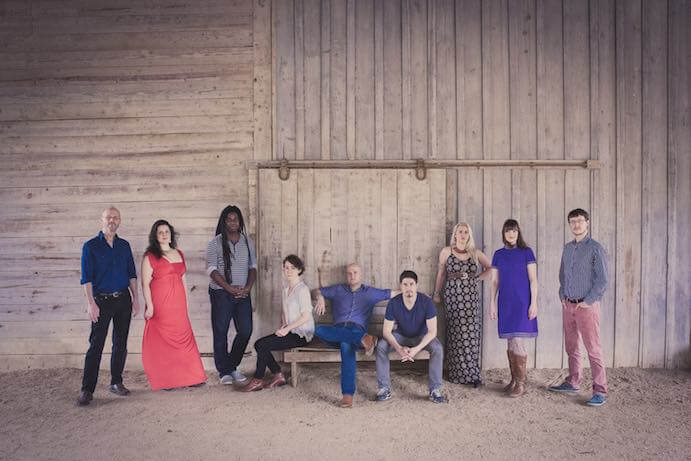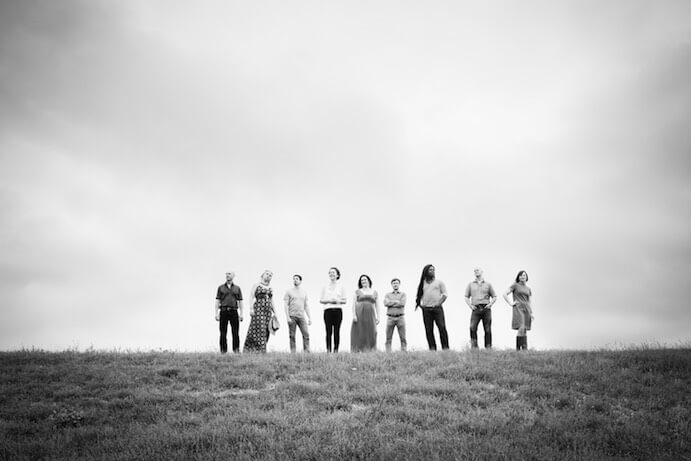“You are not the same as a composer after working with Roomful of Teeth.” Composer Richard Beaudoin described his transformative experience of working with this elite vocal ensemble during their August 26, 2017 performance at the Massachusetts Museum of Contemporary Art. The concert marked the eighth anniversary of their annual commissioning residency, a time dedicated to workshopping new music and revisiting familiar repertoire.
In addition to transforming the way contemporary composers write for the voice, Roomful of Teeth also possesses the ability to fundamentally change the way we listen. The ensemble has assembled a battalion of composers who are intimately familiar with the capabilities and nuances of the group, and as singers, they are able to synthesize a wide array of disparate styles in a way that does not feel contrived. However, despite their impressive conquest of complex harmonies and extended vocal techniques, the precise intonation of their unisons and the perfect balance of their major chords are perhaps even more awe-inspiring. Roomful of Teeth guides the listener toward hearing the basic building blocks of music in a new light, and in doing so, they prove that simplicity and innovation are not mutually exclusive.
The first half opened with a sketch of Rinde Eckert’s haunting There is no stillness, which will eventually become an evening-length theatrical work. The text contemplates the destruction of nature by man through the perspective of a distant personal memory, and Eckert achieves this ambiance through use of reverb-heavy pizzicato violin (performed by Todd Reynolds), a hocketed delivery of the text, and atmospheric Ligeti-like harmonies. Toby Twining’s Overtonework put Roomful of Teeth’s Tuvan throat singing abilities on full display, combining this technique’s characteristic buzzy timbre with crystal clear conventionally sung tones. The work alternates between continual percolation and explosions into the monolithic, widely-spaced chords that your college part-writing professor warned you about, featuring Estelí Gomez’s command of a range far beyond the average soprano tessitura.
Androo O’Hearn’s Yama, God of Death featured and extended vocal technique not often encountered on the classical concert stage—heavy metal singing. Featuring iconic low gravelly timbres, vocal fry, and vocal glissandi that descend into forceful exhales, O’Hearn’s work contrasts intense textural heavy metal effects with glimmers of madrigal-like chorales. Richard Beaudoin’s Superstition sets a text by Amy Lowell to millisecond-level measurements of a player piano roll of Debussy’s Prelude No. 1 using Beaudoin’s own “microtiming” technique. Superstition features additive textures, call-and-response, and homorhythmic singing as a vehicle for sunny, lush harmonies that stand defiantly against the fear-mongering text. Fred Hersch’s Two Haiku served as a gentle conclusion to the first half of program. Polyphonic textures intertwined as the unique timbres of soloists separated from the group, and the opportunity to hear the distinct characteristics of different voices made the coming together into a homogenous balanced whole even more impressive.

Roomful of Teeth–Photo by Bonica Ayala
While the first half featured new works performed with incredible accuracy and musicianship, it was merely a prologue to the full capabilities of Roomful of Teeth as demonstrated through two “lived in” larger works by William Brittelle and Caroline Shaw. Roomful of Teeth Artistic Director Brad Wells prefaced Brittelle’s Psychedelics by likening his compositional style to observing things passing by while driving without focusing on any one particular thing before shifting to a new point of focus. This particular iteration of Psychedelics featured tenor Eric Dudley simultaneously singing and playing a reduction of the full concert choir part on synthesizer. The work unfolds as a series of through-composed jump cuts that navigate a blustering array of textures and styles at a breakneck pace, moving through homophonic chorale singing, overtone singing, bright nasally tones, vocal glisses, Broadway belting, vocal fry, and metal growling.
The evening concluded with Caroline Shaw’s The Isle, a Folger Shakespeare Library commissioned work which imagines the music of the island from Shakespeare’s The Tempest. The work takes the listener on a journey through pre-language communication, monologues by Ariel, Caliban, and Prospero, and finally, a return to non-verbal sound. Gradually building from rapidly re-articulated sustains, the opening paints sounds with swells that wash across the ensemble before beginning to coalesce around the word “come.” Shaw uniquely sets each soliloquy—Ariel’s speech features a mostly homorhythmic delivery of the text separated by a refrain of sonorous glimmering chords; Caliban’s speech was sung by Shaw in a pure, chant-like solo over drones peppered with vocal fry; and Propsero’s speech is recited in a fragmented hocket. With an emphatic declamation of the final line, “I’ll drown my book,” the ensemble faded back into the non-verbal textures and sounds from the opening of the work, and so too left many in the audience speechless from having witnessed something so beautiful.




















